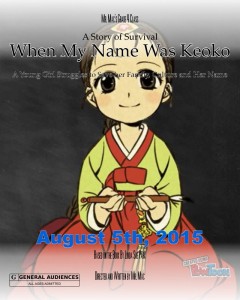Digital Storytelling
Task
Create a complex digital story, educational in nature, using one of a range social media. Your story must:
Be educational
Be a story–not a digital lesson or lecture
Be viewable either as an embedded file or a link on the Story page of your e-portfolio
In addition to the embed/link of the story itself, describe the following on the Story page:
Why was this the right tool for you to use to tell your story, particularly from a pedagogical perspective?
How did you purposefully select this for your storytelling tool?
How does this story work within a course that you teach (or would like to teach) using sound pedagogical arguments?
Reflection
My educational digital story is intended for use by an educator in the classroom with students in Grades 5 or 6. It is a digital story, not a lesson or lecture, although it is meant to be used within a unit dealing with the Japanese occupation of Korea. The intent of this digital story is to inform and be a discussion starter on how the Japanese occupation of Korea is more than just a historical fact, that it had real and personal effects on the people of Korea.
In this embeddable story we meet the Sunhee (aka Keoko) who, with her brother Taeyul, is trying to keep her family together during the turmoil of colonization. The story includes key points in the book where Sunhee or her brother are dealing with the realities of life under Japanese rule. The first scene is between Sunhee and her Uncle, Sunhee’s uncle is recovering from a beating at the hands of the Japanese for printing the Korean flag in his newspaper. Uncle takes time to show Sunhee how to draw the flag of Korea , something that she has never done because it is illegal.
I purposefully selected the following storytelling tools as they are constructivist in nature with an ability to produce multimedia content, allow for collaboration and overall project management (Sadik 2008) for the teacher and students.
From a pedagogical perspective, this instance of digital storytelling in education can provide an alternative to traditional methods and be more interesting for students with the creation of rich digital stories using complex computer graphics, recorded audio, addition of music, video clips, computer generated text and importantly be shared via email, exporting to social networks (e.g., Twitter, Facebook, YouTube) or uploading to a website (Robin, 2008). As in this case, digital stories can be used to facilitate discussion and act as an anticipatory set (Sadik, 2008) when beginning a lesson or larger unit.
In my current teaching reality, I work with schools that have access to these apps (installed or cloud based) and the devices that house them. I can not only model the use of digital stories but later assist teachers and students in creating their own. These specific tools were assessed and chosen due to their easy of use, multimedia production capacities, low to no cost, exporting options and minimal yet intuitive interfaces.
Digital Storytelling Tools Used
The main creative parts of this video was created using this paid digital storytelling app. I chose the paid version because it allows for the user to create their own heads for the puppets. The app allowed for a selection of pre-designed characters and backgrounds. Voices could be assigned to each character and then modified to enable a distinct personality. I liked the anonymity this gave me when ‘acting’ out the script and I feel gave the story more depth. By clicking on a character, I could move, resize and enable to automatic mouth movements to simulate talking. After going through my script, I exported the video directly to YouTube.
This iPad/OSX app was used to create the introduction of the title and characters in the second version of the story. It was mainly used to access theme music and text features. This was then, like version one, uploaded and stitched together using YouTube Editor.
This app provides themed templates for use as intros, trailers and end credits to be used in video production. I chose to adapt one introduction piece in order to capture the attention of the audience with its theatrical music and motion of images. That video was then added to the PuppetPals 2 creation using iMovie.
This is where I created the script for the digital story. This could be a way for students to collaborate on the writing process.
I used this website to create a movie poster for my digital story. I thought the site was child-friendly and provided a nice teaser image to show the day before.
As noted by Robin (2008), digital storytelling can also placed into a conceptually based theoretical framework like Technological Pedagogical Content Knowledge (TPCK) to provide guidance and effectiveness when implemented. TPCK puts a spotlight on the interactions and connections between the subject taught, the teaching processes used, and the technology. By using digital storytelling within such a framework, educators avoid a common trap of treating these components as separate parts thus decreasing the overall effectiveness of the end product.
References
Bates A. W. & Poole, G. (2003).A Framework for Selecting and Using Technology. Effective Teaching with Technology in Higher Education, 4,75- 108.
Robin, B. R. (2008). Digital storytelling: A powerful technology tool for the 21st century classroom. Theory into practice, 47(3), 220-228.
Sadik, A. (2008). Digital storytelling: a meaningful technology-integrated approach for engaged student learning. Educational technology research and development, 56(4), 487-506.
